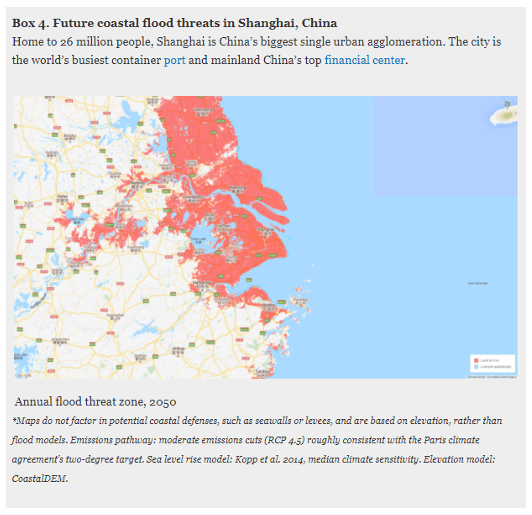Publish Date (HKT) 2021-07-05
[UNSUBSTANTIATED] Will coastal areas of Hong Kong be vulnerable to floods in 2050 as sea level rises?

Screenshot of the WhatsApp messages.
The Claim and Our Verdict
- The claim: WhatsApp messages circulating online claim that coastal areas of Hong Kong will be vulnerable to floods in 2050 as sea level rises.
- Fact-checking:
- The claim originates from a research paper published by the research organization Climate Central in Nature Communications, a research journal of science, in 2019.
- Although Hong Kong is not specified in the abovementioned paper, CoastalDEM, a new digital elevation model developed by Climate Central, shows that many coastal areas of Hong Kong (including New Territories, Kowloon, Hong Kong Island and outlying islands) will be below the elevated sea level.
- Since it is a new model, no consensus on the report’s conclusion has been reached in the academia and the industries. Hong Kong Observatory has a reserved opinion regarding the projection due to significant deviations from previous research and practical experiences.
- Our ruling: Therefore, we rate the claim as UNSUBSTANTIATED.
News Brief
WhatsApp messages circulating online claimed that 300 million people worldwide will be vulnerable to floods due to a rise in the sea levels. Hong Kong’s coastal areas 3 feet below sea level will purportedly face a high risk of flooding, including northwest of New Territories, Kam Tin, Hung Shui Kiu, Chek Lap Kok Airport, West Kowloon and Kai Tak.
Fact-checking
Keyword searches on Google found most of the related news reports were published around October 31, 2019. Most of them mention Climate Central, a research organization, and reference an article published in Nature Communications, an open-access journal in the Nature research journals’ series.
A further keyword search delivered an article published on the website of Climate Central, in which the key information is identical to the claim. It is found that a related research paper was published by Climate Central in Nature Communications. The paper is co-authored by Dr. Scott A. Kulp and Benjamin H. Strauss, both of whom are scientists affiliated to Climate Central. As stated on the website, “Dr. Scott Kulp serves as principal computational scientist, and his research interests include the impacts of sea level rise on coastal communities” and “Dr. Benjamin Strauss was elected President and CEO of Climate Central in April 2018 and also serves as Chief Scientist. He is author of numerous scientific papers and reports on sea-level rise.”

Screenshot of the article published in Nature Communications by Climate Central.
The paper discovered, “more than 70% of the total number of people worldwide currently living on implicated land are in eight Asian countries: China, Bangladesh, India, Vietnam, Indonesia, Thailand, the Philippines, and Japan. China alone accounts for 18–32% of global ECWL (extreme coastal water level) exposure …”
Although Hong Kong is not specified in the research paper, it is mentioned in the article published on Climate Central’s website. The article claims that by 2050, land now home to 93 million people in China will be vulnerable to floods due to the elevated height of coastal flood level. Regions such as Shanghai, Tianjin, Pearl River Delta (including Hong Kong and Macau) will be vulnerable then.

Screenshot of the article published on the official website of Climate Central.
When using “CoastalDEM Mapping Tool” introduced in the article to look up Hong Kong, it can be seen that many coastal areas including New Territories, Kowloon, Hong Kong Island and outlying islands will be below the elevated sea level. According to Climate Central, it has “used the data of 135 countries across multiple climate scenarios in future decades to introduce the most advanced interactive maps accessible to the public, enabling neighbourhood-level exploration and screening of potential threats in areas around the world, based on peer-reviewed science.”

Screenshot of Hong Kong’s coastal areas’ condition in 2050 in CoastalDEM Mapping Tool.
Gabriel Lau, professor of geography and resource management at the Chinese University of Hong Kong, said the new model adopted by Climate Central enabled a more accurate projection than before, according to a Mingpao news article. However, Hong Kong Observatory had a reserved opinion regarding the projection due to significant deviations from previous research and practical experiences, as stated in the news article.
Conclusion
Therefore, we rate the claim as UNSUBSTANTIATED.
References
- Climate Central, search result on the official website.
- Climate Central, “New report triples estimates of vulnerability to sea level rise,” October 29, 2019.
- Nature Communications, “New elevation data triple estimates of global vulnerability to sea-level rise and coastal flooding,” published in 2019.
- Climate Central, introduction of Dr. Scott Kulp and Dr. Benjamin Strauss.
- Climate Central, CoastalDEM Mapping Tool.
- Mingpao, “US research: sea level rise beyond expected; Hong Kong to be widely affected; latest projection: West Kowloon and airport may be submerged by 2050,” October 31, 2019.












 :
:  : 3411 7375
: 3411 7375 :
: